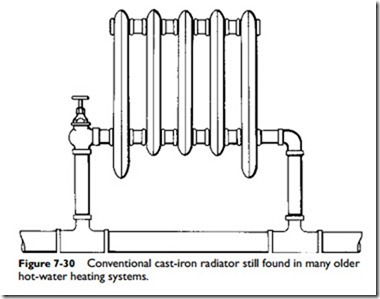Heat-Emitting Units
The hot water in both gravity and forced hot-water heating systems is circulated through the pipes to the radiators or other heat-emitting units, from which the heat is transferred into the room.
Conventional cast-iron radiators (Figure 7-30) are often set on the floor or mounted to the wall. Many examples of these can still be found in older buildings. Some attempts have been made to conceal
radiators by recessing them in the wall of the room or enclosing them (partially or entirely) in cabinets. Recessed radiators must have some sort of insulation between them and the wall. One-inch-thick insulation board, a sheet of reflective insulation, or a combination of both is recommended for this purpose. If the radiator is partially or entirely covered with a cabinet, then openings should be provided at both the top and bottom of the cabinet for air circulation.
Convectors consist of finned tubes enclosed in a cabinet (Figure 7-31) or baseboard unit (Figure 7-32) with openings at the top and the bottom. The hot water circulates through the tubes, which radiate heat. Air enters the bottom of the cabinet or baseboard and exits through the openings in front.
Baseboard radiator units (Figure 7-33) consist of long, narrow tubes directly behind a baseboard face. The hot water flows through the tubes and heats the baseboard face, and the heat is radiated from the surface into the room. Make sure that the metal cover of the baseboard unit is not too thin (an indication of a cheaply built unit). Thin covers are easily dented, and water temperature changes in the heating element can cause a thin base- board cover to be noisy.
Valance units along the top of the walls are also used to distribute the space-heating hot water (Figure 7-34). They were conceived as a solution to the furniture placement problem associated with base- board units. They operate on the same principle as the baseboard units; i.e., the hot water circulates through copper tubing with attached fins, and the heat radiates out into the room.
Radiant floor systems use flexible tubing installed below the floor. The hot water from the boiler circulates through the tubes, and its heat is transferred to the floor surface. Flexible tubes or panels are also used as heat emitters in ceilings and walls.
